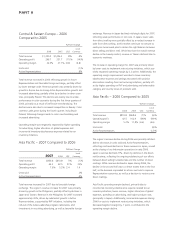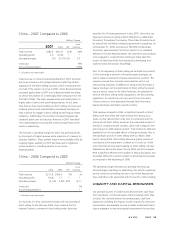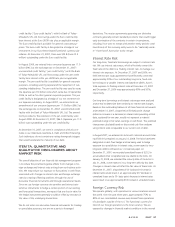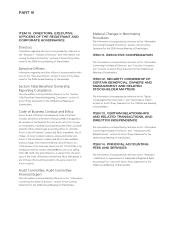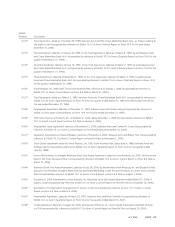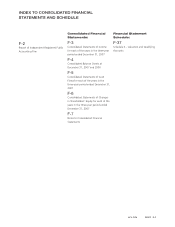Avon 2007 Annual Report Download - page 44
Download and view the complete annual report
Please find page 44 of the 2007 Avon annual report below. You can navigate through the pages in the report by either clicking on the pages listed below, or by using the keyword search tool below to find specific information within the annual report.PART II
course of our operations, primarily due to international busi-
nesses and transactions denominated in foreign currencies and
the use of various financial instruments to fund ongoing activ-
ities. At December 31, 2007, the primary currencies for which
we had net underlying foreign currency exchange rate exposures
were the Argentine peso, Brazilian real, British pound, Canadian
dollar, Chinese renminbi, Colombian peso, the Euro, Japanese
yen, Mexican peso, Polish zloty, Russian ruble, Turkish lira and
Venezuelan bolivar.
We may reduce our exposure to fluctuations in cash flows asso-
ciated with changes in foreign exchange rates by creating off-
setting positions through the use of derivative financial
instruments.
Our hedges of our foreign currency exposure are not designed
to, and, therefore, cannot entirely eliminate the effect of
changes in foreign exchange rates on our consolidated financial
position, results of operations and cash flows.
Our foreign-currency financial instruments were analyzed at
year-end to determine their sensitivity to foreign exchange rate
changes. Based on our foreign exchange contracts at
December 31, 2007, the impact of a 10% appreciation or 10%
depreciation of the U.S. dollar against our foreign exchange
contracts would not represent a material potential change in fair
value, earnings or cash flows. This potential change does not
consider our underlying foreign currency exposures. The hypo-
thetical impact was calculated on the open positions using for-
ward rates at December 31, 2007, adjusted for an assumed 10%
appreciation or 10% depreciation of the U.S. dollar against these
hedging contracts.
Credit Risk of Financial Instruments
We attempt to minimize our credit exposure to counterparties by
entering into derivative transactions and similar agreements only
with major international financial institutions with “A” or higher
credit ratings as issued by Standard & Poor’s Corporation. Our
foreign currency and interest rate derivatives are comprised of
over-the-counter forward contracts, swaps or options with major
international financial institutions. Although our theoretical
credit risk is the replacement cost at the then estimated fair
value of these instruments, we believe that the risk of incurring
credit risk losses is remote and that such losses, if any, would not
be material.
Non-performance of the counterparties on the balance of all the
foreign exchange and interest rate agreements would result in a
write-off of $19.9 at December 31, 2007. In addition, in the
event of non-performance by such counterparties, we would be
exposed to market risk on the underlying items being hedged as
a result of changes in foreign exchange and interest rates.
ITEM 8. FINANCIAL STATEMENTS AND
SUPPLEMENTARY DATA
Reference is made to the Index on page F-1 of our Consolidated
Financial Statements and Notes thereto contained herein.
ITEM 9. CHANGES IN AND
DISAGREEMENTS WITH
ACCOUNTANTS ON ACCOUNTING
AND FINANCIAL DISCLOSURE
Not applicable.
ITEM 9A. CONTROLS AND
PROCEDURES
Evaluation of Disclosure Controls and
Procedures
As of the end of the period covered by this report, our principal
executive and principal financial officers carried out an evaluation
of the effectiveness of the design and operation of our disclosure
controls and procedures pursuant to Rule 13a-15 of the Securities
Exchange Act of 1934 (the “Exchange Act”). In designing and
evaluating our disclosure controls and procedures, management
recognizes that any controls and procedures, no matter how well
designed and operated, can provide only reasonable assurance of
achieving the desired control objectives, and management was
required to apply its judgment in evaluating and implementing
possible controls and procedures. Based upon their evaluation,
the principal executive and principal financial officers concluded
that our disclosure controls and procedures were effective as of
December 31, 2007 at the reasonable assurance level. Disclosure
controls and procedures are designed to ensure that information
relating to Avon (including our consolidated subsidiaries) required
to be disclosed by us in the reports we file under the Exchange
Act is recorded, processed, summarized and reported within the
time periods specified in the Securities and Exchange Commis-
sion’s rules and forms and to ensure that information required to
be disclosed is accumulated and communicated to management
to allow timely decisions regarding disclosure.
Management’s Report on Internal Control
over Financial Reporting
Avon’s management is responsible for establishing and maintain-
ing adequate internal control over financial reporting, as such
term is defined in Rule 13a-15(f) under the Exchange Act.
Internal control over financial reporting is defined as a process
designed by, or under the supervision of, Avon’s principal execu-
tive and principal financial officers and effected by Avon’s board
of directors, management and other personnel, to provide rea-
sonable assurance regarding the reliability of financial reporting






